
Farm To Table – Hamanassett Bed and Breakfast
Cooking school at this Brandywine Valley country inn is a fantasy camp for foodies interested in a truly locatarian experience.
by Stephanie Citron
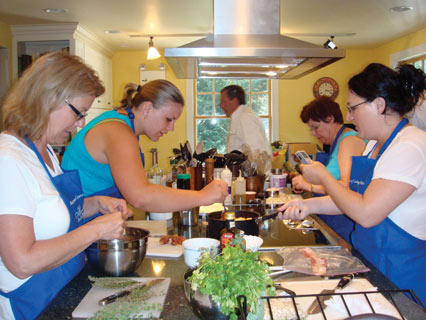
My fellow student chefs and I were contemplating the antique bone china toast rack during breakfast when chef Ann-Michelle Albertson entered the dining room to deliver an announcement.
“In advance to cooking today, our morning will be spent foraging fresh ingredients for our recipes at two different farms and a winery,” she told us. “For our dinner tonight, we’ll be picking fresh corn, tomatoes to make a tomato-water soup, peppers, watermelon to grill for a salad, greens and herbs, peaches for a soufflé and picking up some freshly procured Amish chickens for our main course. Though I’ve pre-planned our dinner menu, it will be flexible, depending upon the fresh bounty we happen upon in our travels today.”
Just listening to Chef Albertson was heaven. Some people fantasize about sports camp; I’ve always dreamed of attending cooking classes at a country inn. I’d spent months researching itineraries, looking for a hands-on cooking program that integrated slow food principles and techniques with local, seasonal ingredients. When I discovered the “Brandywine Bounty” class at Hamanassett Bed and Breakfast, I knew I’d hit the jackpot. Chef Albertson’s credentials sealed the deal: professional training at LaVarenne in Paris, the Culinary Institute of America and many others.
Hamanassett is an elegantly restored, 19th-century mansion on a secluded bluff amid endless meadows and gardens, high above Pennsylvania’s Brandywine Valley. My room featured wide-planked, honey oak floors, antique furnishings and a window overlooking the horse meadow. Awaiting me there when I arrived the previous evening was a tote bag stocked with cooking school supplies: a recipe book, itinerary and an apron. At the welcome reception for cooking students, I’d met my seven fellow classmates, self-taught cooking enthusiasts with varying levels of experience. We all agreed we had much to learn about sustainable agriculture and incorporating fresher food into our diets.
With Chef Albertson and innkeeper Glenn Mon in the lead, we traipsed outside, where we divided into three carloads and set out for Wynnorr Farm, eight miles away through the rolling farmland.
When we arrived, farmer Joe Stratton, whose family had bought the 25-acre property in 1924, herded us aboard a hay wagon hitched to his green John Deere and off we bounced into the fields. My scent detector perked up, drawing in hay, freshly cut silage and corn.
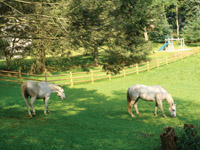 When the wagon rolled to a stop, Stratton hopped down to deliver a mini-dissertation on corn growing. In order for corn to grow from seeds, he explained, pollen must drop from the top, or tassel, of the husk onto the silk. The silk then attaches inside the husk and each thread creates a kernel. “Press in the center… you want a bit of firmness,” he said, advising us how to choose the perfect ear of corn. “Perfectly ripe, farm fresh corn can be eaten right off the husk.” Stratton offered up a nibble to Chef Albertson while the rest of us scampered into the field. Then it was on to the next pasture where Stratton plucked a pepper from the vine, explaining, “Peppers should be dark green and perhaps slightly reddening at their peak.” We wandered the rows, filling our baskets.
When the wagon rolled to a stop, Stratton hopped down to deliver a mini-dissertation on corn growing. In order for corn to grow from seeds, he explained, pollen must drop from the top, or tassel, of the husk onto the silk. The silk then attaches inside the husk and each thread creates a kernel. “Press in the center… you want a bit of firmness,” he said, advising us how to choose the perfect ear of corn. “Perfectly ripe, farm fresh corn can be eaten right off the husk.” Stratton offered up a nibble to Chef Albertson while the rest of us scampered into the field. Then it was on to the next pasture where Stratton plucked a pepper from the vine, explaining, “Peppers should be dark green and perhaps slightly reddening at their peak.” We wandered the rows, filling our baskets.
When we drove away two hours later, our cars were packed with our harvest, including beets, peaches, a watermelon, rosemary and thyme— and the fresh chickens Stratton had procured from a local Amish farmer.
Half an hour later, we were slogging through reeking, runny manure-hay compost at Joseph Silvestri & Son’s mushroom farm. Compost is the key ingredient for a successful mushroom soil, the essential first step to producing pristine white mushrooms. As I gulped air through my mouth to avoid breathing in the stench through my nose, our guide Donna Silvestri-Fecondo described the 10-week mushroom-growing process, which involves producing spores in sterile, climate-controlled chambers and planting them in compost-filled beds. The harvesting room was spellbinding— thousands of mushrooms, in all stages of maturation, poking up from the soil.
“Mushrooms never have to be washed,” Silvestri-Fecondo told us emphatically. The brown “dirt” is peat moss— we should “just brush it off.” But the germaphobe in me had to ask, “How can we trust the hygiene of the handlers at the market?” She shrugged, saying, “Wipe them with a damp cloth.”
See, mushrooms are like sponges, and retain water, so they should never be soaked or scrubbed. Silvestri-Fecondo told us to peek underneath the caps. A closed veil indicates delicate flavor; an open veil signifies richer flavor. We departed with 30 pounds of mushrooms and a few insider tips (including the advice to store mushrooms in the refrigerator in an open bowl or in a porous paper bag, never plastic).
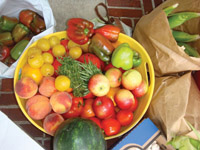 Next, we drove 10 miles over the rolling hills to Penns Woods Winery, where vintner Gino Abruzzo guided us through his 11 acres of prized grapes. New vines take three years to fruit, he told us, and if the elements don’t get the fledgling fruit, predators often do. “It looks beautiful, sounds fantastic and romantic, but really, it’s a lot of hard work,” Abruzzo said with a sigh, quelling our nascent winemaker aspirations.
Next, we drove 10 miles over the rolling hills to Penns Woods Winery, where vintner Gino Abruzzo guided us through his 11 acres of prized grapes. New vines take three years to fruit, he told us, and if the elements don’t get the fledgling fruit, predators often do. “It looks beautiful, sounds fantastic and romantic, but really, it’s a lot of hard work,” Abruzzo said with a sigh, quelling our nascent winemaker aspirations.
Chef Albertson had prepared box lunches of freshly grilled tuna with ripe tomatoes on focaccia, fresh corn and edamame salad, doughnut peaches and a piece of handmade chocolate-covered brickle. We sat on the winery porch, munching away and sipping on several Penns Woods wines: a dry 2008 Traminette, a crisp, fruity 2005 Chardonnay Reserve and a rich, plumy blush wine, yet to be named.
Back at the inn, we stationed ourselves at the cutting boards set on the spacious countertop. “Today you are locatarians,” pronounced Chef Albertson, “part of a growing movement who have chosen to eat provisions from within a short radius of where you live.” Based on our morning trip— specifically the bounty of mushrooms and beets we’d collected— Chef Albertson announced several additions to the evening meal: a sautéed beets side dish, a mushroom bruschetta topping and mushroom sauce for the chicken.
We divided into cooking groups and I joined forces with my classmate Denise to prepare the main course, the watermelon salad and a baguette for bruschetta. During the next three hours, we sliced and toasted a baguette, plucked thyme, sage, oregano and rosemary from their stems and minced them finely and pressed the herbs into unsalted butter. I stuffed the goopy mixture under the skin of our fresh chickens and Denise stuffed the cavities with fragrant herb sprigs and garlic cloves. Finally, we coated the birds with olive oil, sea salt and pepper.
Chef Albertson advised us to crisp the skin first, then tent the chickens and reduce the heat for roasting, which would seal in the juices and prevent overcooking. While the chicken roasted, I lined the rim of eight salad plates with endive, scattered in pine nuts and feta and drizzled balsamic syrup over everything. I left the center free for the watermelon, which would be seared on a Panini grill just before serving. I beamed when Chef Albertson glanced at my plates and sang, “Bee-uu-tii-ful!”
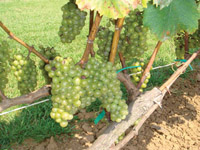 By early evening, the kitchen smelled glorious. Chef Albertson shooed us out with orders to rest and return for dinner at 7 p.m.
By early evening, the kitchen smelled glorious. Chef Albertson shooed us out with orders to rest and return for dinner at 7 p.m.
At dinner, a formal seated affair served by the inn staff, we chatted about our kitchen adventures and proclaimed our dishes extraordinary. Highlights were the grilled watermelon salad, the tomato-water soup served with a seared scallop and the roasted corn. The fresh chicken was also delicious: tangy, mildly gamey and juicy.
After a good night’s sleep and another delicious breakfast, I returned home vowing to purchase regional, seasonal produce and avoid processed foods and chain restaurants. And I vowed to cook slowly and thoughtfully. Eagerly, I began with dinner that night: steaks in a mushroom wine sauce and grilled corn-on-the-cob with herb butter.
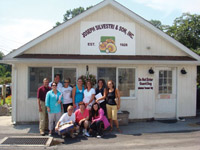 Hamanassett Bed and Breakfast is in the Brandywine Valley, just across the Delaware/Pennsylvania border. Cooking class package includes two nights’ accommodation, breakfast each morning, a welcome reception, lunch and dinner prepared during the cooking class and class materials. $650 per couple, double occupancy; $575, single. 725 Darlington Road, Chester Heights, Pa. 610-459-3000. http://www.hamanassett.com .
Hamanassett Bed and Breakfast is in the Brandywine Valley, just across the Delaware/Pennsylvania border. Cooking class package includes two nights’ accommodation, breakfast each morning, a welcome reception, lunch and dinner prepared during the cooking class and class materials. $650 per couple, double occupancy; $575, single. 725 Darlington Road, Chester Heights, Pa. 610-459-3000. http://www.hamanassett.com .
Copyright @ 2016, Baltimore Style
